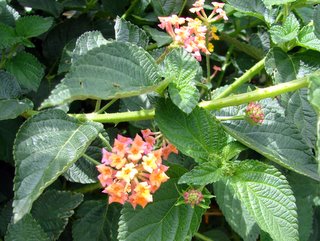Lantana camara,
an evergreen perennial, erect, and aromatic shrub originates from
tropical America. It is invasive in Africa. In Bwindi Impenetrable
National Park (BINP), it has invaded the Northern sector of the park
where it has replaced much of the native vegetation. It is preferred by
farmers for its brightly colored flowers (pink and yellow on opening,
changing to red and orange and on rare occasions purple and blue) and is
widely planted in the community lands surrounding BINP. L. camara
is believed to inhibit and/or suppress the growth of native plant
species. Its spreading also has a shading effect that inhibits the
growth of native seedlings. Propagation of L. camara is both
vegetative and by seed.

The main objective of this
study was to determine the impact of L. camara on the growth of
native tree species, its ability to spread and its possible control. The
study was conducted in the Northern part of BINP. The research used
paired nested quadrats in both invaded and non- invaded areas. The data
was analyzed using SYSTAT 8.0. Shannon Weiner indices were used in
the comparison of diversity; while species richness, stem density and
tree regeneration comparisons were made using Mann-Whitney U test.
The Mann-Whitney U test was also used to compare regeneration of native
plant species in permanently established quadrats in order to find
appropriate means of L. camara control. The relationships between
L. camara stem density and other tree species stem density were
tested using Spearman’s rank correlation.
L. camara
was found in open forest gaps and disturbed areas where it formed thickets. It was also seen to grow under tree cover where it would grow
vertically towards the canopy. The native tree species' regeneration
potential, species richness, diversity and stem density were
significantly higher in non-invaded areas.
Herbs and seedlings showed
more diversity in invaded areas. This can be attributed to low evenness
in non-invaded area.
L. camara percentage cover and number
of thickets were negatively related to plant densities and species which
could be because less diverse areas are more susceptible to invasion.
L. camara's
vegetative regeneration was significantly higher than that
by seed. Its expansion was observed to be mainly through terminal branching. A
large L. camara seed bank was found once the thickets were
eliminated, which could be attributed to the need for light during
germination.
The tree species which tolerate L. camara include:
Xymalos monospora, Markhamia lutea and Clausena anisata.
However, the weight of L. camara thickets made them produce poor
and unhealthy lateral branches. In permanently established quadrats of
cut and uprooted L. camara, native vegetative regeneration was
significantly higher in cut quadrats than in uprooted quadrats (U=
400.00; p= 0.001; x2= 29.459). Reseeders did not show any
significant difference in both areas (U= 179.50; p= 0.58; x2=
0.308). Areas where L. camara was uprooted were more diverse than where
it was cut (H/= 0.684 and 0.596 respectively).
Since L.
camara inhibits the growth of native plants, it should be
eradicated. Repeated uprooting and burning of L. camara thickets
is recommended as the best method of control in BINP.


